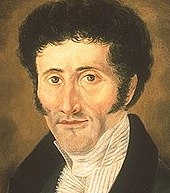Night pieces (Hoffmann)
The night pieces are a narrative cycle by ETA Hoffmann , which consists of eight fantastic stories. They were written in Berlin between 1815 and 1817 and were published there in two parts in 1816 and 1817.
content
The first part includes the narratives
- The Sandman ,
- Ignaz Denner ,
- The Jesuit Church in G. as well
- The Sanctus .
Appeared in the second part
- The desolate house ,
- The majorat ,
- The vow and
- The stone heart .
Titling
With the title of the first edition, Nachtstücke, edited by the author of the Fantasiestücke in Callot's manner , Hoffmann referred to his previous collection, which was very successful.
Hoffmann, who was familiar with the title Night Pieces from Jean Paul , turned with this collection to the dark side of life, the uncanny and threatening aspects of apparently demonic powers that lead people into fear, despair and madness. Although he did not entirely avoid the spooks and shudders of ghost stories , what mattered to him above all was the uncanny phenomena of the soul, including the effects of psychological disorders, processes that are quickly described as pathological and that he wanted to interpret and make artistically experienceable.
The title of Robert Schumann's piano cycle published in 1839 is derived from this work.
background
The term Nachtstück , which comes from art history , referred, as it is called in the German dictionary , to the “pictorial representation of a nocturnal scene”, to scenes and representations with clear light-dark contrasts. In this way, certain areas are illuminated while others remain hidden in the darkness of the night. Examples of this can be found in the works of Caravaggio , Jacob van Ruisdael and Rembrandt, who was revered by Hoffmann .
In the course of the 18th and early 19th centuries, the word was also used in a broader sense, for example by Wieland and Goethe , Jean Paul and Clemens Brentano , whereby, in addition to the original meaning , the concept of nocturnal as a metaphor for endangered and extreme states of the mind appeared.
In the 18th century, the increasing interest in the grotesque and the uncanny, death and dying, first became apparent in horror literature and English grave poetry . Under the influence of German idealism and dialectical thinking and in search of a comprehensive explanation of human existence, the night was upgraded to a symbol for areas that eluded rational knowledge. Under the sign of the universal poetry of Friedrich Schlegel , Novalis sang the night in his hymns to the night , a work whose influence can be felt in Richard Wagner's Tristan und Isolde .
In August Klingemann attributed vigils appears this dark side of the day negative by a period satire with questions of themselves nihilism connects. Here the ego is exposed to the uncanny nocturnal nature, an environment in which Hoffmann's nocturnal pieces also move.
Web links
- Night pieces at Zeno.org .
Individual evidence
- ↑ Sabine Laußmann, in: Kindlers Neues Literatur Lexikon, Volume 7, ETA Hoffmann, Nachtstück, Munich, 1990, p. 958
- ^ Gero von Wilpert, Lexikon der Weltliteratur, Werklexikon, Nachtteile, p. 942
- ↑ Sabine Laußmann in: Kindler's new Literaturlexikon, Volume 7, ETA Hoffmann, nocturnes, Munich, 1990, p 959
- ↑ Killy Literature Lexicon, Sachlexikon: Nachtstück, Volume 14, p. 140
